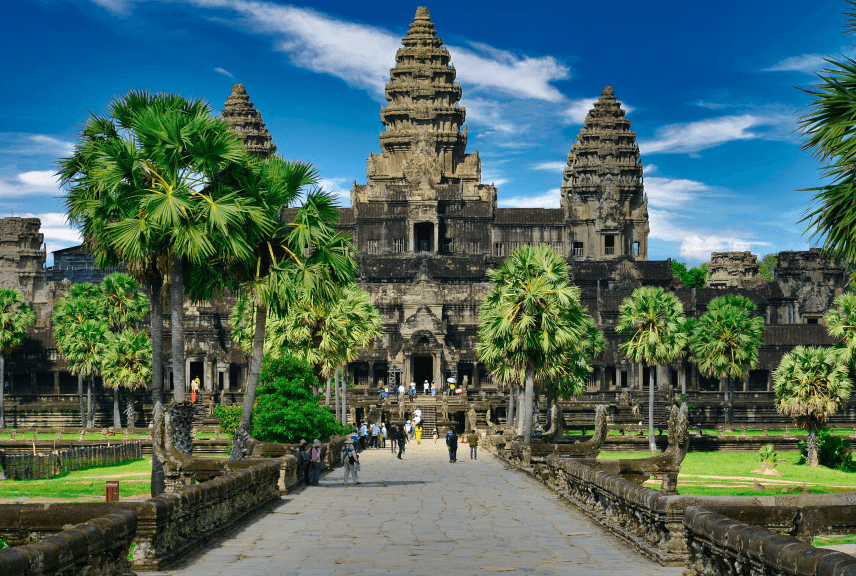Buddhist Meditation
Suan Mok, a 120-acre forest temple in Chaiya district, Surat Thani province, some 580 kilometres south of Bangkok, attracts and accepts meditators from all over the world. Meditation opportunities are also found in Bangkok, particularly at Wat Mahathat (facing Sanam Luang), Wat Pak Nam, Wat Chonprathan Rangsit, Wat Phrathammakai and Banglamphu’s Wat Bowon Nivet where English language instruction is available.
Wildlife Sanctuaries / National Parks
Thailand has some so national parks and wildlife sanctuaries covering more than 25,000 square kilometres. Evenly spread throughout the kingdom, such places afford nature lovers opportunities to enjoy Thai flora and fauna in unspoiled surroundings. The most popular in terms of convenient accessibility and immediately visible attractions are as follows: Khao Yai National Park lies some 200 kilometres north-east of Bangkok, covers more than 540,000 acres, has an average elevation of 800 metres and a highest peak of 1,351 metres. The park supports elephants, tigers, bears, giant hornbills and other protected wildlife, countless species of wild flowers, trees and spectacular waterfalls. Doi Inthanon National Park in Chiang Mai province covers Thailand’s highest mountain (2,565 metres). Forest above 1,800 metres is covered with lichens and wild orchids while at lower levels several lovely waterfalls share the mountainside with Meo and Karen hilltribe villages. Ko Samet in Rayong province is the focal point of a Marine National Park. The narrow, 6 kilometre long island numbers among Thailand’s most beautiful islands and is fringed by splendid beaches, dazzling coral reefs and limpid waters ideal for snorkelling and scuba-diving. Erawan National Park in Kanchanaburi province is extremely popular. The mountainside forest setting contains the seven-tiered Erawan Waterfall, widely regarded as one of Thailand’s loveliest cascades. Sam Roi Yot National Park in Prachuap Khiri Khan province provided major settings for the award-winning movie The Killing Fields. A multi- peaked, thinly forested limestone mass rises majestically from coastal marshes that host numerous waterfowl species. Caves, islands, fine beaches and frequently seen wildlife comprise major attractions. Khu Khut Waterfowl Park in Songkhla province occupies 520 square kilometres of the Great Songkhla Lake and hosts some 140 resident and migratory species. Ao Phang Nga National Park in Phang Nga province featured prominently in the James Bond movie The Man With The Golden Gun. Verdant limestone islands, honeycombed with caves and aquatic grottoes, soar perpendicularly from almost perpetually calm waters. Major attractions include prehistoric rock paintings and a stilted Muslim fishing village. Tarutao Marine National Park in Satun province, 31 kilometres off the southern Thai coast near the Thai-Malaysian Indian Ocean maritime border, is a 51-island cluster covering some 1,400 square kilometres, and offers some of Southeast Asia’s best scuba-diving waters. Ko Samui and Ang Thong Marine National Park, covering an area of over 250 square kilometres, is located in Surat Thani province and composed of various islands noted for silvery sand and colourful coral reefs. Access to the islands can be made either from Ban Don, Surat Thani or Don Sak in Nakhon Si Thammarat.
Elephant Training
The recently opened Thai Elephant Conservation Centre, 28 kilometres outside Lampang on the main highway to Chiang Mai, has replaced the former Elephant Training School at Ngao. Logging training sessions for young elephants are held daily at 9.00 AM in an attractive forest setting, and visitors are welcome.
Thai Fruits
Thai fruits – – including mangoes, mangosteens, durians, pineapples, watermelons, papayas, rambutans, longans, lyches, tamarinds, pomegranates, palm fruits, oranges, pomeloes, jackfruits and more than 20 kinds of bananas- – are available all year round. From January to April, grapes, jackfruits, java apples, tangerines, watermelons and pomegranates are in season. Next corne mangoes, lyches, pineapples, durians and mangosteens. From July on, longans will ripen, and also langsats, jujubes, passionfruits, pomeloes, rambutans, sugar apples and again tangerines, grapes, water- melons. bananas, coconuts, guavas and papayas are available throughout the year. Some harvests are celebrated in style, with colourful festivals, sometimes featuring a pageant of local beauties. In early April, the Paet Riu Mango Festival is organized in Chachoengsao. Probably the most popular and typical of Thai fruits, the mango deserves this honour. In May, Songkhla promotes its fruits with a bazaar, fruit carving demonstrations and a Miss Southern Thailand Pageant. In June, Chanthaburi exhibits delicious provincial fruits, including the king of them all, the exquisitely delicious durian. In September, to honour pomeloes, a fruit and floral float procession is held in Nakhon Pathom, near Bangkok.
Traditional Thai Massage
Courses are taught principally in Bangkok’s Wat Pho, “home” of traditional Thai massage. Thai massage is also offered in Wat Mahathat and Wat Parinayok, both in Bangkok.
Art and Crafts
During 1976, Her Majesty Queen Sirikit established the Foundation for the Promotion of Supplementary Occupations and Related Techniques, popularly known as SUPPORT, with the object of giving rural Thais alternative sources of income and also of reviving some of the kingdorn’s traditional crafts. The result has been a variety of beautiful items available in Thailand through a chain of outlets called Chitrlada Shops. Five Chitrlada Shops are located in Bangkok: on the ground floor of the Decorations PaviIion in the Grand Palace: in the Oriental Plaza shopping centre; in the shopping arcade of the Hilton International Bangkok Hotel; in the compound of Wimanmek Mansion; and at Don Muang International Airport. Others can be found at the Rose Garden in Nakhon Pathom province, in South Pattaya, and at the Chiang Mai Airport. Among the SUPPORT products to be found in these shops are handwoven silks from the Northeast, particularly in subtle ikat designs known in Thai as rnat-mi; elegant yan liphao handbags, made from a vine that grows in southern Thailand and often adorned with gold fittings; jewellery in distinctive designs; supple Thai cotton in classic patterns; T-shirts with motifs designed by Her Royal Highness Princess Maha Chakri Sirindhorn; and numerous moderately-priced souvenirs. All funds raised from the sale of these crafts go to the SUPPORT project.
Orchid Farms
Several establishments in the suburbs of Bangkok, and in Chiang Mai and Chonburi province welcome visitors who may wish to admire, purchase or learn more about these fabled blooms.
Jungle Treks
Most popularly originating from Chiang Mai and Chiang Rai, these 2-6 day treks take visitors through forested mountains and high meadows in what are, actually, the lower extremities of Himalayan foothills. Major attractions are remote hilltribe villages. Mountains surrounding Chiang Mai and Chiang Rai host seven major, once-itinerant hill tribes of Tibeto- Burman origin – the Meo, Lisu, Lahu, Yao, Akha, Lawa and Karen. Each have distinctive dialects, costumes and customs.
Festivals and Annual Events
Thais are fun-loving, sentimental people and annual festivals, both commemorative and celebrative, play important roles in Thai life. Many Thai festivals are joyful, colourful events that invite visitors’ participation. Others feature solemn, eminently photogenic ceremonial. Whatever their character, whether dazzling processions, Buddhist devotion, uninhibited merriment or exotic ritual, each affords the visitor pleasant memories and insights into the cultural heritage that makes Thailand Asia’s most exotic country. Most festivals are connected either with Buddhism, the annual rice-farming cycle, or commemorations honouring Thai kings. Some occur on fixed dates. Others, particularly those associated with Buddhism, are determined by the lunar calendar. Many merit national holidays. Chronologically, Thailand’s major festivals, and events, are as follows :
Makha Puja
Full-moon day, February National holiday This commemorates the occasion when 1,250 disciples spontaneously gathered to hear the Buddha preach. Merit-making, such as offering food to monks, and freeing captive birds and fishes, is interspersed with sermons throughout the day. After sunset, Buddhist monks lead the laity in a lovely triple candlelit circumambulation of Buddhist chapels throughout the kingdom. Each person silently carries flowers, glowing incense and lighted candles in homage to the Buddha, his teaching and his disciples.
Flower Festival
Usually early February. At Chiang Mai, 700 kilometres north of Bangkok. This annual event features displays, floral floats, and beauty contests when the province’s temperate and tropical flowers are in full bloom.
Pattaya Festival
Early April. Thailand’s premier beach resort celebrates with beauty parades, floral floats, and special events, Highlights include a spectacular beach-side firework display.
Songkran Festival
April 13 – 15. National holiday, April 12 – 14 Songkran is the traditional Thai New Year and is celebrated with special elan in Chiang Mai where because it occurs during a time of relative leisure, it becomes a 3-5 day carousel of religious merit-making, pilgrimages, beauty parades, dancing and uninhibited, good-natured water throwing.
Songkran Festival, Amphoe Phra Pradaeng
The second week of April. The Mon community of Phra Pradaeng district, Samut Prakan province, just south of Bangkok, celebrates Songkran with similar festivities.
Royal Ploughing Ceremony
Usually early May, at Bangkok’s Sanam Luang. This ceremony marks official commencement of the annual rice-planting cycle. Presided over by His Majesty the King, elaborate Brahman ritual and ceremonial combine to provide predictions concerning the forthcoming rice crop.
Rocket Festival
The second weekend of May, and best seen in Yasothon, north-east Thailand. Prior to the annual monsoons, Northeast villagers construct gigantic rockets to fire into the sky to ‘ensure’ plentiful rain during the forthcoming rice season. The Rocket Festival is traditionally a period for letting off steam before ardous field work begins in earnest, and features beauty parades, folk dances, ribald and high-spirited revelry before the rockets are ceremoniously launched.
Visakha Puja
Full Moon day, May. National holiday. Visakha Puja is the holiest of all Buddhist holy days, and marks the Buddha’s birth, enlightenment and death. Merit-making and ceremonial are identical to Makha Puja,
Fruits Fairs Countrywide
These annual fairs feature delicious provincial fruits – including rambutan, durian, jackfruits and pomeloes, and feature cultural displays, exhibitions and folk art. Major provinces that celebrate fruits fairs include Rayong, Chanthaburi, Chachoengsao and Hat Yai in Songkhla.
H.M. the Queen’s Birthday
August 12. National holiday Nation-wide celebrations find particular focus in Bangkok where government buildings are decorated and illuminated at night with coloured lights.
Ok Phansa & Thot Kathin
During October. Ok Phansa celebrates the end of the Rains Retreat and introduces the Kathin period when, throughout Thailand, the Buddhist laity present monks with new robes and other items deemed
necessary for the monkhood’s upkeep during the forthcoming monastic year.
Vegetarian Festival
During October. Phuket islanders of Chinese ancestry commit themselves to a vegetarian diet for nine days. The festival’s first day features a parade of white-clothed devotees and several ascetic displays.
Boat Races
October. The Kathin period marks the official end of the Rains Season and is the time for country fairs, many of which feature regattas. Nan, 790 kilometres north of Bangkok, has famous boat races, Other noteworthy regattas are held in Surat Thani, Phichit, Nakhon Phanom and Pathurnthani.
Loi Krathong
Full-moon night of November. This is Thailand’s loveliest festival when under the full moon, Thais float away onto rivers and waterways, Krathongs, small lotus-shaped banana- leaf boats containing a lighted candle, glowing incense, a flower and small coin to honour, it is believed, the water spirits, and to wash away the previous year’s sins.
Elephant Round-Up
Third weekend of November, Surin, north-east Thailand. Some 100 elephants participate in this popular event. Between folk dances and traditional cultural performances, these versatile behemoths star in displays of time-honoured wild elephant hunts, demonstrations of intelligence, strength, gentility and obedience, and the spectacular re-enactment of a medieval war elephant parade.
River Kwai Bridge Week
Late November, early December, Kanchanaburi, western Thailand. Features a thrilling son et lumiere show at the world-famous bridge. Archaeological and historical exhibitions, sparkling folk culture performances and rides on trains hauled by World War II vintage steam locomotives number among other attractions.
H.M. the King’s Birthday
December 5. National holiday. On December 3, the elite Royal Guards swear anew their allegiance to His Majesty King Bhumibol in a colourful and stirring ceremony in Bangkok’s Royal Plaza. On December 5, festivities occur throughout Thailand. Customarily, government buildings and houses are decorated with spectacular illuminations at night. Night-time Bangkok, particularly in the Ratchadamnoen Avenue and Grand Palace area, becomes a floodlit fairyland of coloured lights







